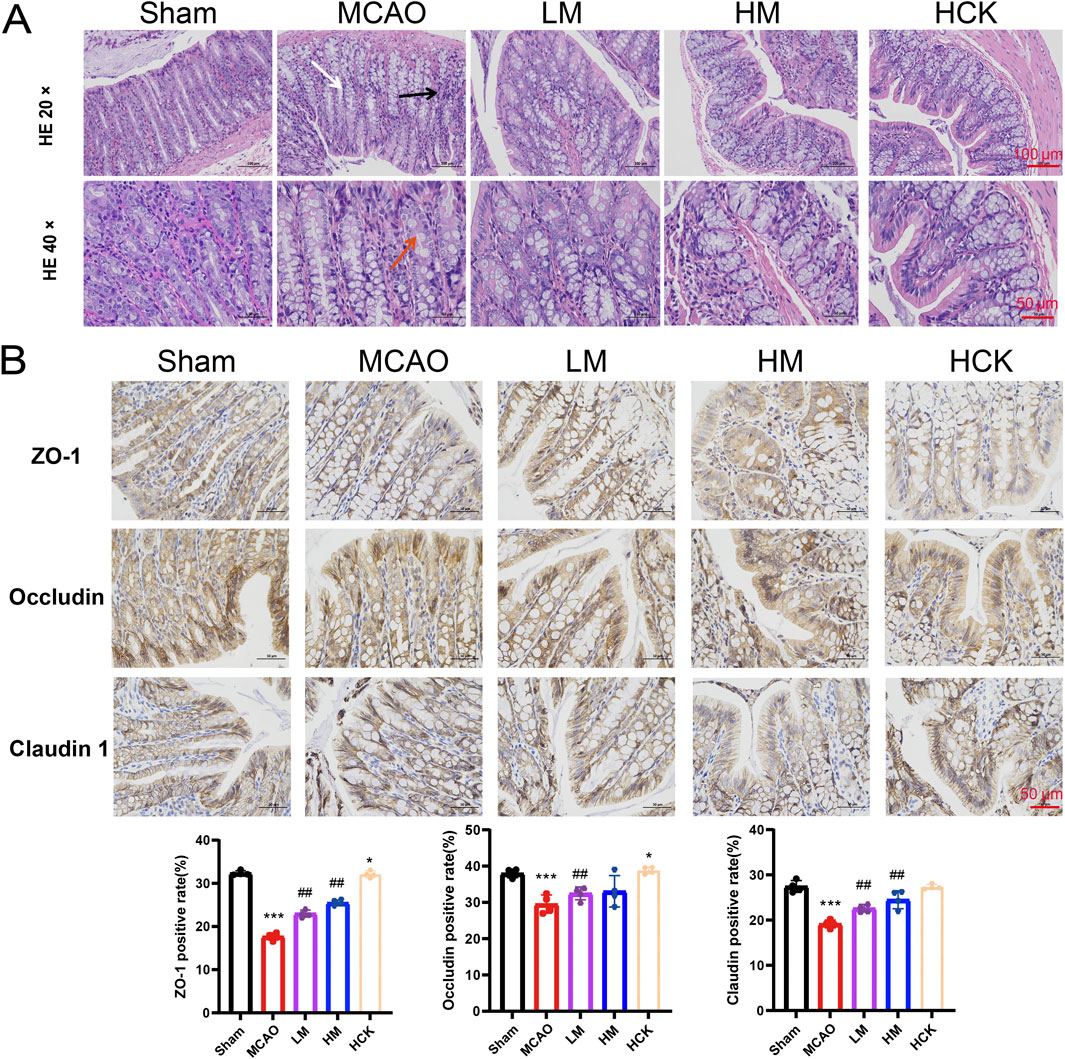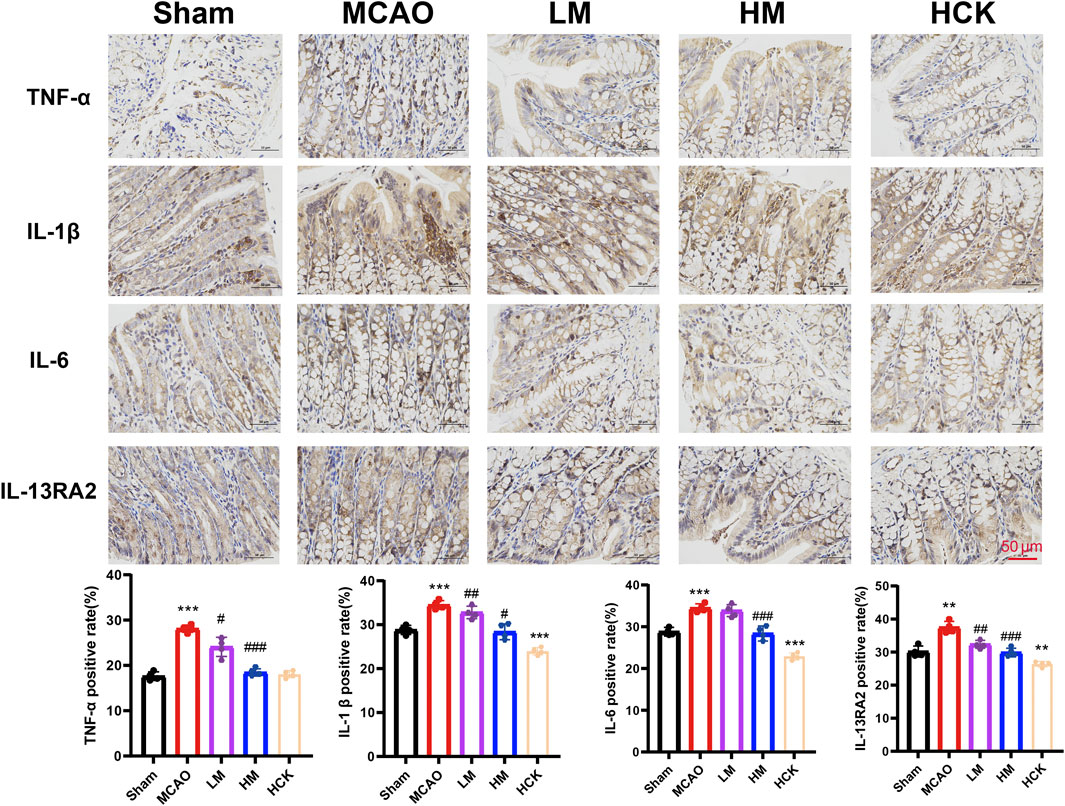- 1School of Pharmacy and School of Biological and Food Engineering, Changzhou University, Changzhou, China
- 2School of Pharmacy, Modern Industrial College of Traditional Chinese Medicine and Health, Lishui University, Lishui, China
- 3Center of Molecular Metabolism, Nanjing University of Science and Technology, Nanjing, China
- 4The Second People’s Hospital of Changzhou, The Third Affiliated Hospital of Nanjing Medical University, Changzhou, China
- 5Changzhou Medical Center, Nanjing Medical University, Changzhou, China
by Ruan L, Wang Z, Zheng M, Zheng Q, Qing Q, Lin H, Tao Y, Wang L, Wang J and Ge W (2025). Front. Pharmacol. 16:1580055. doi: 10.3389/fphar.2025.1580055
There was an error in Figure 3 as published. The authors inadvertently substituted a 40× image from the Sham group with a 40× image from the HCK group in Figure 3A. Because intestinal histology differs markedly between groups (fold architecture, mucosal arrangement, etc.), the mismatch was readily apparent. The incorrect original 40× image of the Sham group was an enlarged image of the HCK 20× image. The authors have now retrieved the correct 40× micrographs for both the Sham and HCK groups from the raw data and have reconstructed Figure 3A accordingly. The corrected Figure 3 appears below.

Figure 3. PMP has an ameliorating effect on colon injury in MCAO rats. (A) Representative micrographs of H&E staining in the colon. (B) Representative immunohistochemical images and statistical maps of tight junction protein. n = 4. *p < 0.05, **p < 0.01 and ***p < 0.001, MCAO group vs. Sham group; #p < 0.05, ##p < 0.01 and ###p < 0.001, dosing group vs. MCAO group.
There was an error in Figure 4 as published. Previously, in Figure 4B the scale bar was positioned outside the image. This has now been adjusted to ensure a consistent style. The corrected Figure 4 appears below.

Figure 4. PMP ameliorates MCAO-induced inflammatory response in rats' colon. Representative immunohistochemical images and statistical maps of inflammatory factors. n = 4. *p < 0.05, **p < 0.01 and ***p < 0.001, MCAO group vs. Sham group; #p < 0.05, ##p < 0.01 and ###p < 0.001, dosing group vs. MCAO group.
The original version of this article has been updated.
Publisher’s note
All claims expressed in this article are solely those of the authors and do not necessarily represent those of their affiliated organizations, or those of the publisher, the editors and the reviewers. Any product that may be evaluated in this article, or claim that may be made by its manufacturer, is not guaranteed or endorsed by the publisher.
Keywords: polygoni multiflori radix praeparata, polysaccharides, acute ischemic stroke, gut microbiota, metabolomics
Citation: Ruan L, Wang Z, Zheng M, Zheng Q, Qing Q, Lin H, Tao Y, Wang L, Wang J and Ge W (2025) Correction: Polygoni Multiflori Radix Praeparata polysaccharides enhance gut health and mitigate ischemic stroke by regulating SCFA and amino acid metabolism in gut microbiota. Front. Pharmacol. 16:1636607. doi: 10.3389/fphar.2025.1636607
Received: 28 May 2025; Accepted: 02 June 2025;
Published: 16 June 2025.
Edited and reviewed by:
Michael Heinrich, University College London, United KingdomCopyright © 2025 Ruan, Wang, Zheng, Zheng, Qing, Lin, Tao, Wang, Wang and Ge. This is an open-access article distributed under the terms of the Creative Commons Attribution License (CC BY). The use, distribution or reproduction in other forums is permitted, provided the original author(s) and the copyright owner(s) are credited and that the original publication in this journal is cited, in accordance with accepted academic practice. No use, distribution or reproduction is permitted which does not comply with these terms.
*Correspondence: Junsong Wang, d2FuZy5qdW5zb25nQGdtYWlsLmNvbQ==; Wenhao Ge, d2VuaGFvZ2UzMzIzQG5qbXUuZWR1LmNu
†These authors have contributed equally to this work and share first authorship
 Lingyu Ruan
Lingyu Ruan Zhennan Wang2†
Zhennan Wang2† Qing Qing
Qing Qing Junsong Wang
Junsong Wang Wenhao Ge
Wenhao Ge